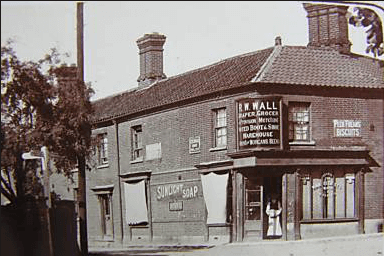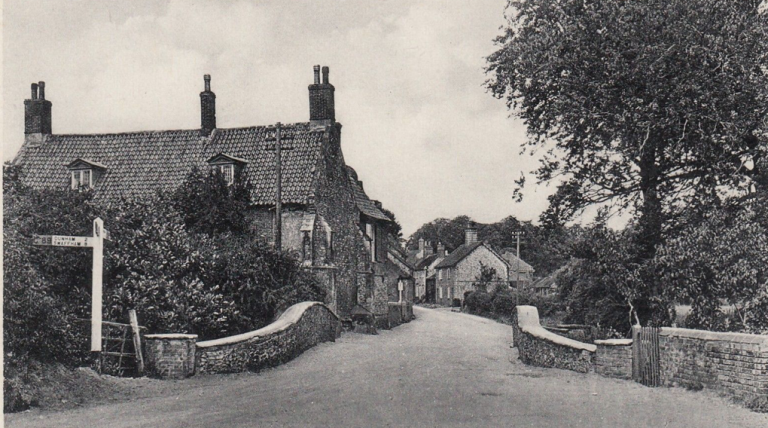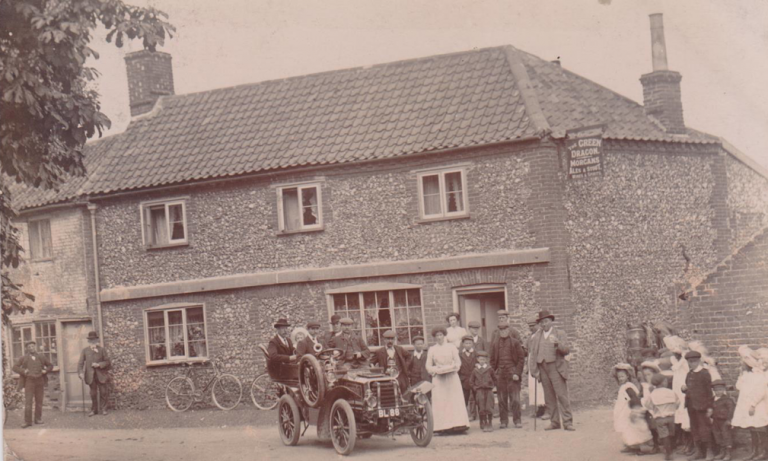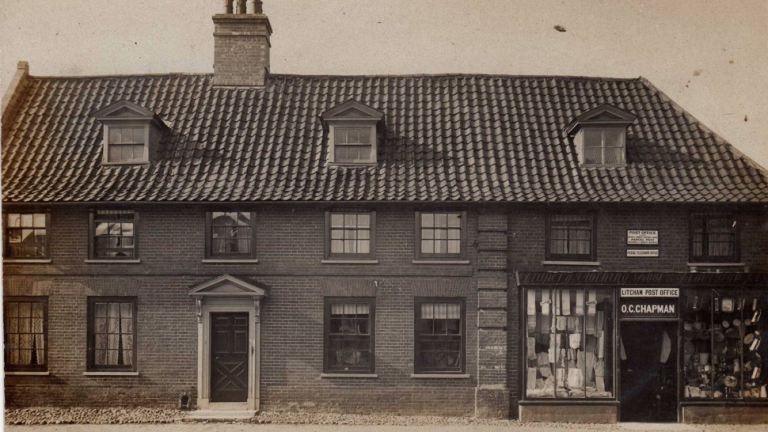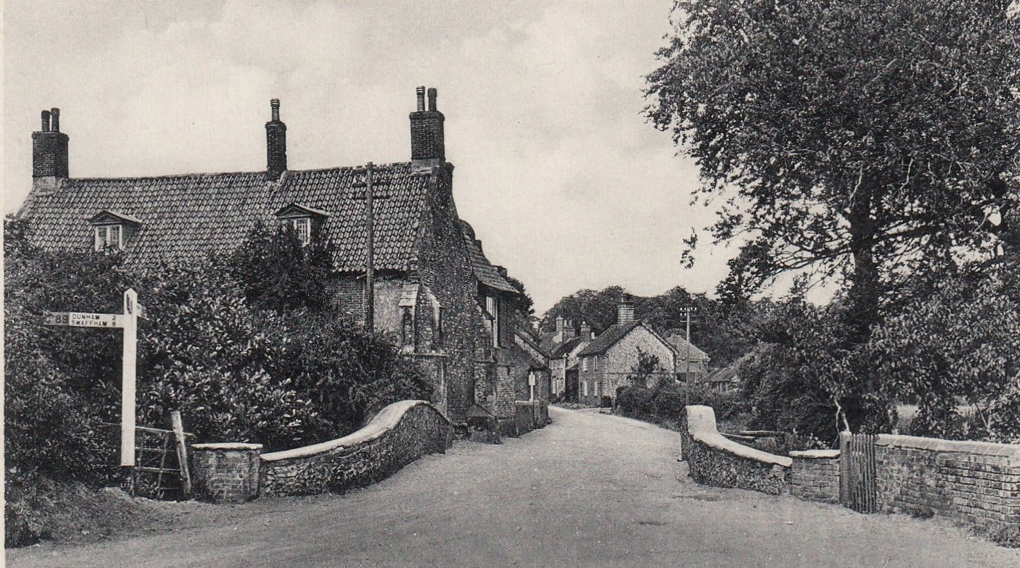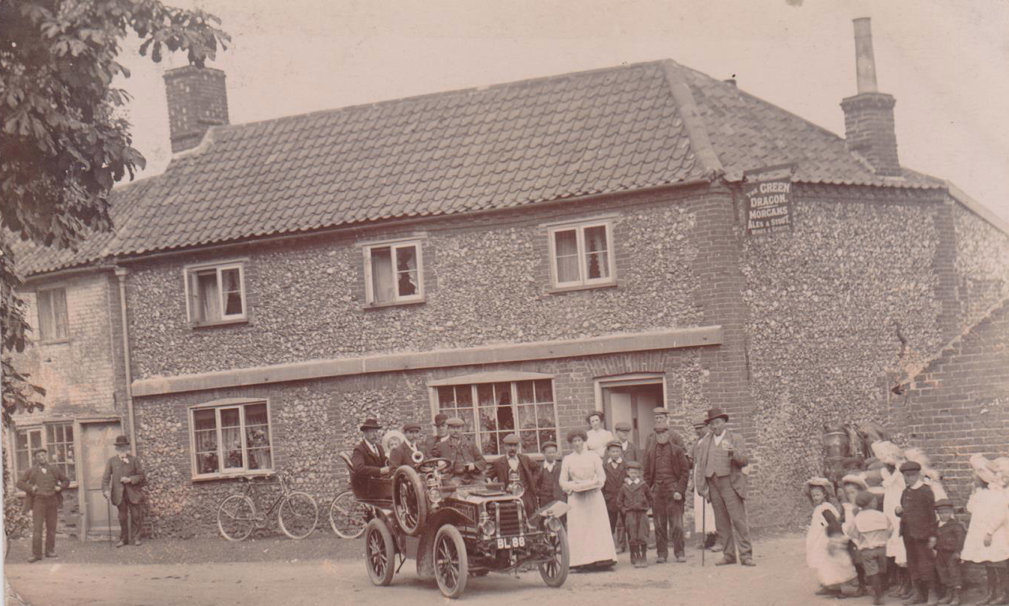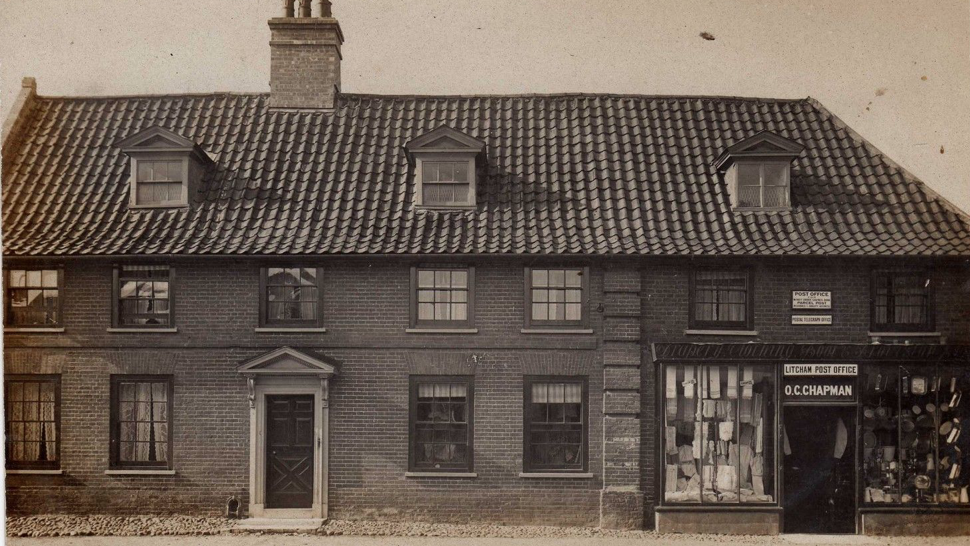The village of Litcham in Breckland, Norfolk
Litcham is in the Breckland district of Norfolk and it is situated near to three local market towns; Dereham, Fakenham and Swaffham. In 1831 the population was 771 and most of the people living here were involved in agriculture, in 2011 the population was 618 and, as is the case with the rest of the area, few are involved in farming.
The Brecks in general, was well populated during the Roman period and the Romano-British presence was strong here in the Litcham area, with a Roman road forming part of the parish boundary on the South and the road from Toftrees to North Pickenham passing through the present village.
Litcham is mentioned in the Domesday Book as Licham and, although there was a Church mentioned, sadly, nothing remains above ground. It is thought likely that it stood on the same site as the one we see presently, but the present building dates from around 1300, rebuilt in 1412, with later additions. The red brick tower was added in 1669 and was paid for by Matthew Halcott, more about him later.
On a pillar in the Church is what is known as “The Litcham Cryptogram” and it has puzzled scholars for centuries. The only thing which all seem to agree on, is the date, which is put between 1300 and 1500, but the letters above are of a later date and it may not even be a true cryptogram. The debate continues.
There is also a Methodist Chapel, built in 1909, on Front Street and a small village hall next to the Church, in what was the village school.
Edward I granted Litcham the right to hold a weekly market and that went on till the early C19th.
Although agriculture was the main employer in the village, the tanning industry was also very important in Litcham in the past and one particular family, the Hallcotts, made a considerable fortune. Matthew Halcott gave a lot back to the village by building the Church tower and paying for a church bell. His brother John, who was living in King’s Lynn at the time of his death, paid for the village Almshouses to be built and for another bell in the tower. A John Halcott gave a Communion Cup and Flagon, with his name inscribed on, to the Church in 1682. An idea of what Matthew Halcott could have looked like, complete with his tanning equipment, is shown on the village sign.
Litcham is on a major crossroads and its position has helped the village to develop. The main roads from King’s Lynn to Norwich and on to Great Yarmouth, the road from Wells, through Fakenham to Dereham and beyond and many routes connecting local villages pass through Litcham, making it a very important meeting point. In the past, there was a small market in the village.
There were several pubs in the village in the past, with The Bull being the most important. The Bull was not only a coaching inn, it was also where the local sessions were held and parts of the building date back to the C14th.
There is also a Methodist Chapel, built in 1909, on Front Street.
All Saint’s Church isn’t the only Medieval building in the village. The Priory at the bottom of Church Street dates back to the 14th century, is more likely to have been a Chapel or Hermitage. The building stood inside a moated enclosure and close to the bridge, which carried the road into the village, so it was in a very important position and the first building seen by visitors from the South.
Litcham Common is situated on the road up to Kempston and Dunham and is a managed Nature Reserve consisting of 28 hectares of lowland heath and mixed woodlands. Today, we have Dartmoor ponies and some cattle which were introduced as part of a scheme to re-introduce grazing and help prevent the growth of encroaching scrub.
The Nar Valley Way is a 35 mile long distance footpath from East Dereham to Kings Lynn and it runs across the common and passes through beautiful scenic countryside along lanes and tracks closely following the river Nar.
Today the village has all the necessary amenities, a Post Office and General Store, a Butcher and a Health Centre. There is a Primary and High School and a Children’s Centre providing pre-school education for Litcham and surrounding villages. If you are a business, group, club or organisation in the village, please do get in touch with us or add your listing to the site here:
https://www.visitbreckland.org.uk/join/
The village of Litcham in 1883:
LITCHAM is a parish 3 miles north-east-by-north fromDunham Station on the Lynn branch of the Great Eastern railway, and 9 north-west from East Dereham, in the Western division of the county, Launditch hundred, Mitford & Launditch union, East Dereham county court district, rural deanery of Brisley and archdeaconry of Norfolk and diocese of Norwich. The Church of All Saints is a large edifice of flint with stone dressings, in the Early English style: it has chancel, nave, aisles and south porch, with a square brick tower containing five bells, and has been thoroughly restored and re-seated: an oak screen of elaborate workmanship of the early part of the fifteenth century, separates the nave from the chancel, in which there are several memorials: in 1851 two stained windows were put up in the south aisle by D. Lynes esq. and Miss C. Lynes, in memory of their parents. The register dates from the year 1550. The living is a discharged rectory, consolidated with that of East Lexham, in the gift of and held since 1855 by the Rev. George William Winter M.A. of University College, Oxford. The tithes are commuted for £440 and there are 45 acres of glebe and house. There are chapels for Wesleyans and Primitive Methodists. Here are a variety of small charities, and an almshouse for two aged persons. A portion of the commons has been enclosed, but there are still upwards of 50 acres left for recreation and the use of the poor. The Rev. W. A. W. Keppel B.A. of Lexham Hall, who is lord of the manor, and William Thomas Collison esq. of Bilney Hall, are the chief landowners. The soil is various; subsoil, gravel and clay. The chief crops are barley, wheat and roots. The area is 1,932 acres; rateable value £3,442; the population in 1881 was 801.
Parish Clerk, William King.
POST, MONEY ORDER & TELEGRAPH OFFICE & Savings Bank.— Nicholas Polkinghorne, postmaster. Letters received from Swaffham at 5.45 a.m. & dispatched at 6.40 p.m.
COUNTY MAGISTRATES FOR THETFORD & LAUNDITCH
PETTY SESSIONAL DIVISION.
Capt. Henry Elwin Hyde, Montague house, East Dereham
Rev. William Henry Augustus Keppel, East Lexham Swaffham
Charles North esq. Rougham
Clerk to the Magistrates, Walter May Barton, East Dereham
Petty Sessions are held at the Bull Inn, Litcham, about four times in the year at 11 a.n. and at East Dereham every Friday.
The parishes in this division are:—
Beeston, Beetley, East Bilney, Brisley, Colkirk, Great Dunham, Little Dunham, North Elmham, Great Fransham, Little Fransham, Gateley, Gressenhall, Hoe, Horningtoft, Kempston, East Lexham, West Lexham, Litcham, Longham, Mileham, Oxwick, Rougham, Scarning, Stanfield, Swanton Morley, Tittleshall, Weasenham All Saints, Weasenham Saint Peter, Wellingham, Whissonsett and Worthing. Cranworth, East Dereham, Garvestone, Hardingham, Hockering, Letton, Mattishall Burgh, Mattishall, Reymerstone, Shipdham, Southburgh, Thuxton, East Tuddenham, North Tuddenham, Westfield, Whinburgh, Woodrising & Yaxham.
County Police Station, Robert Short, inspector; the local force consists of 4 constables
PUBLIC OFFICERS:—
Medical Officer Litcham District of Mitford & Launditch Union, Henry Raven F.R.C.S.
Inspector of Police, Robert Short
National School (boys, girls & infants), built in 1845 for 190 children, average attendance 126; Nicholas Polkinghorne, master; Mrs. Emma Polkinghorne, mistress; Miss Caroline Page, infants’ mistress
CARRIER.—Robert Gunton, to East Dereham on Friday & to Norwich, return Saturday
Derisley Miss
Farrer William Money
Raven Henry
Sizeland Mrs
Temple-Lynes Miss
Winter Rev. George William M.A. (Rector)
COMMERCIAL.
Archer George, farmer
Ashley George Alfred, pig dealer
Askew Edward, farmer
Askew Sharman, watch maker
Baker William Carmichael, plumber & glazier
Banham John, bricklayer
Burrows Davey, painter
Burton Abel, King’s Arms & machine owner
Carter James Nicholson M.R.C.V.S. veterinary surgeon
Catton George, tailor
Chatten James, farmer
Collison George, carpenter
Collison Henry, shoe maker
Cooke Charles Essam, farmer, High house
Copeman William Hicks, saddler & harness maker
Cottrell John, New Inn
Crispe George, carpenter & builder
Cullum George, pork butcher
Curtis William, builder & contractor
Fitt James, baker
Fitt James, jun. painter
Hobson Alfred, farmer
Howard Benjamin, basket maker
Johnson Thomas, shoe maker
Judd James, ironmonger & oil merchant
King John, wheelwright & carpenter
King William, tailor & parish clerk
Laws Susan (Mrs.), shoe maker & leather cutter
Massingham Ripps, butcher & farmer
Middleton Joseph, farm bailiff to Rev. W. A. W. Keppel
Mitchell James Parker, wheelwright
Munday David, surgeon
Overton Jacob, hardwareman
Overton John, shoe maker
Polkinghorne Nicholas, confectioner, fancy stationer, & post office
Ramm George, blacksmith
Randall William Fortin, grocer & draper
Raven Henry F.R.C.D. surgeon & medical officer Litcham district of Mitford & Launditch Union
Rayner Frederick, plumber & glazier
Richmond Elizabeth. (Miss), ladies’ school
Ringwood John, The Bull Inn
Savage Samuel, shopkeeper
Short Robert, inspector of police
Wagg George, blacksmith
Wales Emma (Mrs.), straw bonnet maker
Walker Charles Stapleton, The Green Dragon
Ward John, grocer & draper & wine merchant
Waters George, blacksmith
White Walter, chemist & druggist
Wright James, baker
No Records Found
Sorry, no records were found. Please adjust your search criteria and try again.
Google Map Not Loaded
Sorry, unable to load Google Maps API.
Contact Us
Find Us:
Litcham
Norfolk
PE32 2NS
